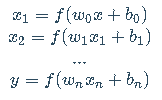用神经网络拟合数据
1 神经元
从本质上讲,神经元不过是输入的线性变换(例如,输入乘以一个数[weight,权重],再加上一个常数[偏置,bias]),然后再经过一个固定的非线性函数(称为激活函数)。
神经元:线性变换后再经过一个非线性函数

数学上,你可以将其写为o = f(wx + b),其中 x 为输入,w为权重或缩放因子,b为偏置或偏移。f是激活函数,在此处设置为双曲正切( tanh)函数。通常,x 以及 o 可以是简单的标量,也可以是向量(包含许多标量值)。类似地,w 可以是单个标量或矩阵,而 b是标量或向量(输入和权重的维度必须匹配)。在后一种情况下,该表达式被称为神经元层,因为它通过多维度的权重和偏差表示许多神经元。
多层神经网络例子由下面的函数组成:

其中神经元层的输出将用作下一层的输入。请记住,这里的 w0w_0w0 是一个矩阵,而 xxx 是一个向量!在此使用向量可使 w0w_0w0 容纳整个神经元层,而不仅仅是单个权重。
一个三层的神经网络:

激活函数:(深度)神经网络中最简单的单元是线性运算(缩放+偏移)然后紧跟一个激活函数。在你的上一个模型中有一个线性运算,而这个线性运算就是整个模型。激活函数的作用是将先前线性运算的输出聚集到给定范围内。
几个常见及不常见的激活函数:

2、PyTorch的nn模块
实例化nn.Linear并将其像一个函数一样进行调用
import torch.nn as nn linear_model = nn.Linear(1, 1) # 参数: input size, output size, bias(默认True) linear_model.weight # 权重 linear_model.bias # 偏差linear_model.parameters() # 参数
nn中的任何模块都被编写成同时产生一个批次(即多个输入)的输出。 因此,假设你需要对10个样本运行nn.Linear,则可以创建大小为 B x Nin 的输入张量,其中 B 是批次的大小,而 Nin 是输入特征的数量,然后在模型中同时运行:
x = torch.ones(10, 1)
linear_model(x)
现在更新原来的训练代码。首先,将之前的手工模型替换为nn.Linear(1,1),然后将线性模型参数传递给优化器:
linear_model = nn.Linear(1, 1)
optimizer = optim.SGD(
linear_model.parameters(), # 之前,你需要自己创建参数并将其作为第一个参数传递给optim.SGD
lr=1e-2)
用神经网络代替线性模型作为近似函数:
接下来我们将重新定义模型,并将所有其他内容(包括损失函数)保持不变。还是构建最简单的神经网络:一个线性模块然后是一个激活函数,最后将输入喂入另一个线性模块
# nn提供了一种通过nn.Sequential容器串联模块的简单方法: seq_model = nn.Sequential( nn.Linear(1, 13), nn.Tanh(), nn.Linear(13, 1)) seq_model
from collections import OrderedDict seq_model = nn.Sequential(OrderedDict([ ('hidden_linear', nn.Linear(1, 8)), ('hidden_activation', nn.Tanh()), ('output_linear', nn.Linear(8, 1)) ])) seq_model
完整代码:
#!/usr/bin/env python # coding: utf-8 # In[1]: import torch import torch.nn as nn import torch.optim as optim torch.set_printoptions(edgeitems=2) torch.manual_seed(2020) # In[2]: t_c = [0.5, 14.0, 15.0, 28.0, 11.0, 8.0, 3.0, -4.0, 6.0, 13.0, 21.0] t_u = [35.7, 55.9, 58.2, 81.9, 56.3, 48.9, 33.9, 21.8, 48.4, 60.4, 68.4] t_c = torch.tensor(t_c).unsqueeze(1) # <1> t_u = torch.tensor(t_u).unsqueeze(1) # <1> t_u.shape # In[3]: n_samples = t_u.shape[0] n_val = int(0.2 * n_samples) shuffled_indices = torch.randperm(n_samples) train_indices = shuffled_indices[:-n_val] val_indices = shuffled_indices[-n_val:] train_indices, val_indices # In[8]: t_u_train = t_u[train_indices] # t_u里的测试集 t_c_train = t_c[train_indices] # t_c对应t_u测试集的部分 t_u_val = t_u[val_indices] # t_u里验证集 t_c_val = t_c[val_indices] # t_c里对应t_u验证集的部分 t_un_train = 0.1 * t_u_train # 相当于把t_u里的数据*0.1 t_un_val = 0.1 * t_u_val # In[6]: linear_model = nn.Linear(1, 1) # 参数: input size, output size, bias(默认True) linear_model(t_un_val) # In[9]: # 现在你有一个具有一个输入和一个输出特征的nn.Linear实例,它需要一个权重 linear_model.weight # In[10]: # 一个偏差 linear_model.bias # In[12]: # 你可以用一些输入来调用这个模块 x = torch.ones(1) linear_model(x) # In[13]: # nn中的任何模块都被编写成同时产生一个批次(即多个输入)的输出 x = torch.ones(10,1) linear_model(x) # In[14]: # 这就是你要切换到使用nn.Linear所要做的。你需要将尺寸为 B 的输入reshape为 B x Nin,其中Nin为1。你可以使用unsqueeze轻松地做到这一点: t_c = [0.5, 14.0, 15.0, 28.0, 11.0, 8.0, 3.0, -4.0, 6.0, 13.0, 21.0] t_u = [35.7, 55.9, 58.2, 81.9, 56.3, 48.9, 33.9, 21.8, 48.4, 60.4, 68.4] t_c = torch.tensor(t_c).unsqueeze(1) # <1> t_u = torch.tensor(t_u).unsqueeze(1) # <1> t_u.shape # In[15]: linear_model = nn.Linear(1, 1) optimizer = optim.SGD( linear_model.parameters(), lr=1e-2) # In[16]: print(linear_model.parameters()) print(list(linear_model.parameters())) # In[17]: def training_loop(n_epochs, optimizer, model, loss_fn, t_u_train, t_u_val, t_c_train, t_c_val): for epoch in range(1, n_epochs + 1): t_p_train = model(t_un_train) loss_train = loss_fn(t_p_train, t_c_train) t_p_val = model(t_un_val) loss_val = loss_fn(t_p_val, t_c_val) optimizer.zero_grad() loss_train.backward() optimizer.step() if epoch == 1 or epoch % 1000 == 0: print('Epoch %d, Training loss %.4f, Validation loss %.4f' % ( epoch, float(loss_train), float(loss_val))) # In[18]: linear_model = nn.Linear(1, 1) optimizer = optim.SGD(linear_model.parameters(), lr=1e-2) training_loop( n_epochs = 3000, optimizer = optimizer, model = linear_model, loss_fn = nn.MSELoss(), # 不再使用自己定义的loss t_u_train = t_un_train, t_u_val = t_un_val, t_c_train = t_c_train, t_c_val = t_c_val) print() print(linear_model.weight) print(linear_model.bias) # nn提供了一种通过nn.Sequential容器串联模块的简单方法: # In[19]: seq_model = nn.Sequential( nn.Linear(1, 13), nn.Tanh(), nn.Linear(13, 1)) seq_model # In[20]: [param.shape for param in seq_model.parameters()] # In[21]: for name, param in seq_model.named_parameters(): print(name, param.shape) # Sequential还可以接受OrderedDict作为参数,这样就可以给Sequential的每个模块命名: # In[22]: from collections import OrderedDict seq_model = nn.Sequential(OrderedDict([ ('hidden_linear', nn.Linear(1, 8)), ('hidden_activation', nn.Tanh()), ('output_linear', nn.Linear(8, 1)) ])) seq_model # In[23]: for name, param in seq_model.named_parameters(): print(name, param.shape) # In[24]: optimizer = optim.SGD(seq_model.parameters(), lr=1e-3) # 为了稳定性调小了梯度 training_loop( n_epochs = 5000, optimizer = optimizer, model = seq_model, loss_fn = nn.MSELoss(), t_u_train = t_un_train, t_u_val = t_un_val, t_c_train = t_c_train, t_c_val = t_c_val) print('output', seq_model(t_un_val)) print('answer', t_c_val) print('hidden', seq_model.hidden_linear.weight.grad) # In[26]: from matplotlib import pyplot as plt t_range = torch.arange(20., 90.).unsqueeze(1) fig = plt.figure(dpi=100) plt.xlabel("Fahrenheit") plt.ylabel("Celsius") plt.plot(t_u.numpy(), t_c.numpy(), 'o') plt.plot(t_range.numpy(), seq_model(0.1 * t_range).detach().numpy(), 'c-') plt.plot(t_u.numpy(), seq_model(0.1 * t_u).detach().numpy(), 'kx') plt.show() # In[ ]:



 浙公网安备 33010602011771号
浙公网安备 33010602011771号